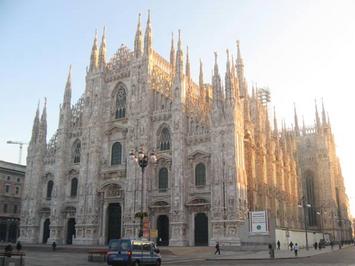
Italy's population growth has been stagnating in recent decades, but has turned around during the last decade, with the annual growth rate increasing 16 times (from 0.04 percent to 0.69 percent). According to United Nations data, Italy added more international migrants in the 2000s (3.8.5 million) than it added people in any ten year period since 1960. Some of the strongest growth has been in the Milan metropolitan region, which has begun to grow again after years of stagnation. This is not due to any increase in Italian birth rates but principally because of surging international migration.
Much of this has to do with the enlargement of the European Union (EU) from 15 to 27 member states, and the consequent removal of all legal barriers to internal migration. The Milan metropolitan region, occupies much of Lombardy, Italy's most populated region. Milan added 634,000 foreign residents in just six years (2000 to 2008, the latest year for which data is available). The largest share, 103,000, was from the EU's Romania, with 50,000 from Albania, 47,000 from Morocco, 30,000 each from Ecuador and Egypt and 27,000 from Ukraine. Over the period, more than 80 percent of Lombardy's growth has come as a result of international immigration. The key to this lies with the region’s economy, which is the strongest in Italy and all of southern Europe.
International migration has also fueled large population increases elsewhere, especially in both northern and central Italy, such as Rome and Turin. Further south, however, growth (such as in the Naples area) has continued to be comparatively slow (Figure 1).
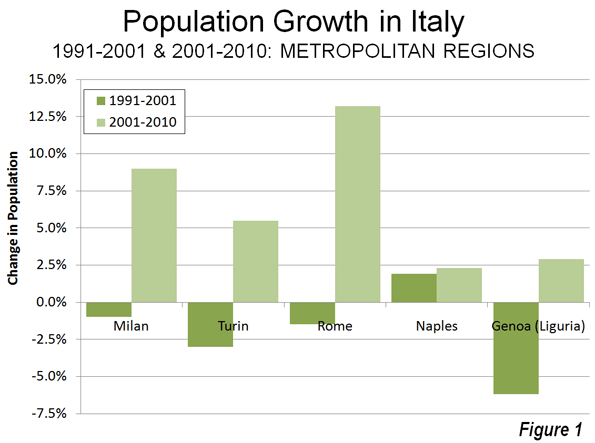
The Urban Area: The Milan urban area is the largest in Italy. The Milan urban area stretches from the core of Milan northward to the Alps and includes development in the provinces of Varese (photo), Como, and Lecco (Photo: Lecco) as well as Monza and Brianza. The province of Como is home to the picturesque Lake Como, while Varese sits at the foot of the Simplon Tunnel (of "Venice Simplon-Orient Express" fame) and the highway over Simplon Pass to Brig in Switzerland's Rhone Valley and the Matterhorn.
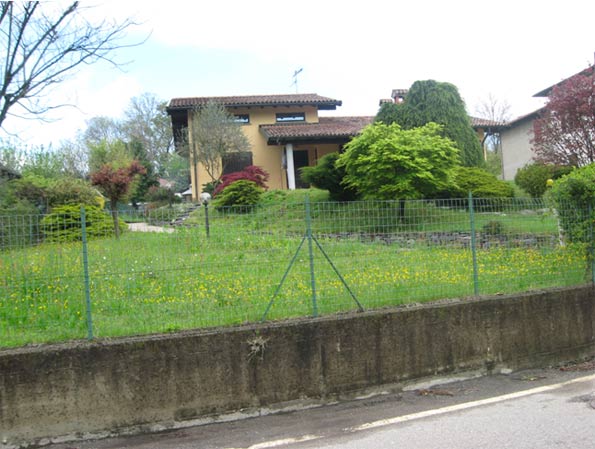
Varese
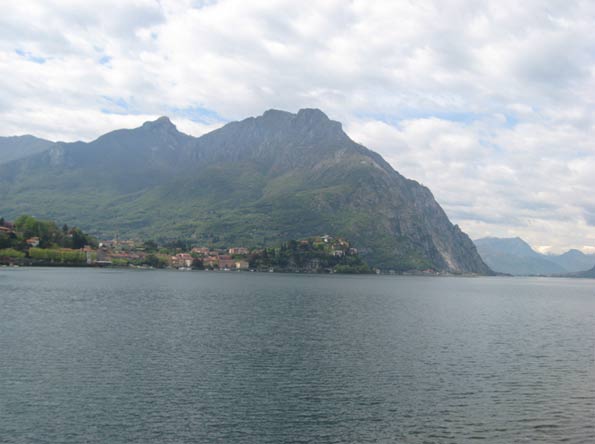
Lecco: Northernmost suburbs
There is also considerable development both to the east and the west in the province of Milan and more limited development to the south. Overall, the urban area has a population of approximately 5,400,000 (Note 1), covering approximately 800 square miles (2,100 square kilometers) for a population density of approximately 6,700 per square mile (2,500 per square kilometer). This is similar to that of Los Angeles or Toronto.
Growth in the Metropolitan Region: Until the recent increase in international migration, the Milan metropolitan region was growing slowly and more recently even losing population. Between 1991 and 2001, the metropolitan region lost one percent of its population. However, since 2001 the metropolitan region has gained 9.0 percent, an improvement from the minus 1.1 percent between 1991 and 2001. The last decade's growth was at an average annual increase rate of 0.96 percent which is slightly more than the United States (0.94 percent) and slightly less than Canada (1.04 percent).
The Inner City: The commune of Milan is the central municipality of Milan metropolitan region. The population of Milan peaked in 1971 at just under 1,700,000 people. By 2001 the population had fallen to approximately 1,250,000 people, a loss of approximately 25 percent and its lowest population since before the 1951 census. The central municipality of Milan continued to lose population to 2001. From 1991 to 2001, Milan lost more than 100,000 people and nine percent of its population. Milan is not unusual in this decline. Declines have been characteristic for virtually all Western European central municipalities, except where there was substantial greenfield space to accommodate new suburban development (such as in Rome).
However, the commune of Milan has begun to grow again. Milan's population has increased by nearly 70,000 people or 5.4 percent. Milan now has a population density of 18,600 per square mile (7,200 per square kilometer), slightly higher than that the city of San Francisco (Photo: Milan). Even with the recent increase, however, all of the growth in the Milan metropolitan region since 1991 has been in the suburbs and exurbs (Figure 2) and 87 percent in the last decade (Figure 3).
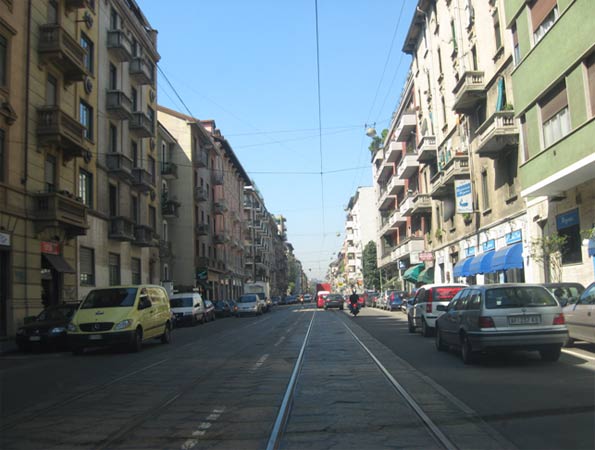
Milan
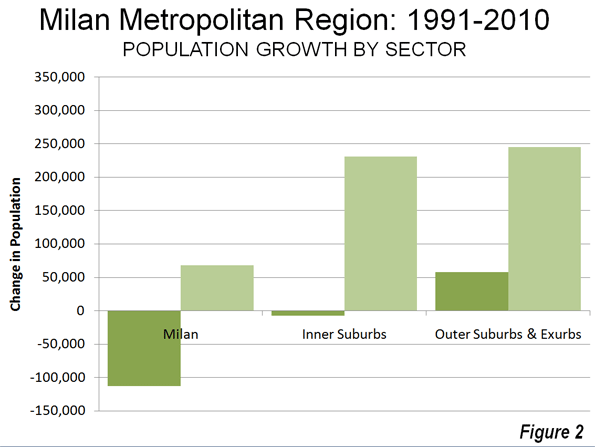
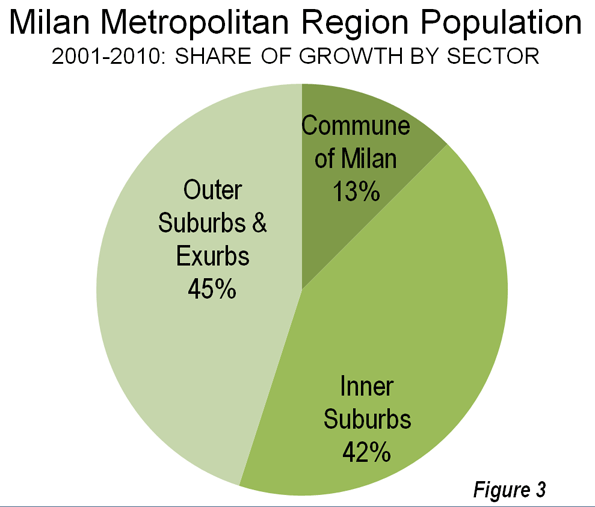
Much of the commune's population increase has been the result of international migration, since many Italians continue to migrate to the surrounding suburban and exurban areas, as is the case in a number of European metropolitan regions. Domestic out-migration continued from the commune of Milan, while the suburbs and exurbs attracted domestic migrants (Note 2).
Inner Suburbs: The inner suburbs of Milan include portions of the province of Milan outside the commune of Milan and the (single) province of Monza and Brianzia, which was separated from the province of Milan earlier in the decade. The inner suburbs also lost population between 1991 and 2001. This was reversed between 2000 and 2010, when the inner suburbs added approximately 230,000 people, and grew at an overall rate of 9.4 percent. The inner suburbs have a population density of approximately 5,000 per square mile (1,900 per square kilometer), somewhat less than the Sydney urban area and 1.5 times that of Portland.
Outer Suburbs and Exurbs: The outer suburbs and exurbs stretch north to the foot of the Alps, as well as to the south of the province of Milan. The largest population is to the north, with a far smaller population to the south, in the exurban provinces of Pavia and Lodi. Unlike the commune of Milan and the inner suburbs, the outer suburbs and exurbs have grown in each of the last decades. Between 1991 and 2001, the outer suburbs and exurbs accounted for all the growth, though at a modest rate of 2.5 percent. The growth has substantially increased since 2001 with the addition of more than 245,000 new residents and a growth rate of 10.4 percent. International migration accounted for 93 percent between 2002 and 2008, 93 percent were foreign (202,000).
Where the Immigrants are Moving: As might be expected with strong international migration, most of the new entrants have moved to the inner city and inner suburbs. Between 2002 and 2006, 97 percent of the population growth was from international migration, with an addition of 202,000. The overall foreign population increased 119 percent from 2002 to 2008. Yet, the percentage growth was much stronger in the outer suburbs and the exurbs, where the foreign population grew 171 percent (125,000). However, this represented a smaller share of the overall growth (67 percent), which is likely to be an indication of strong outbound domestic migration from the inner city and the inner suburbs to the outer suburbs and exurbs. There was also strong foreign population growth in the balance of Lombardy, with an increase of 147 percent, which constituted a somewhat higher share of overall growth, at 84 percent (Figure 4).
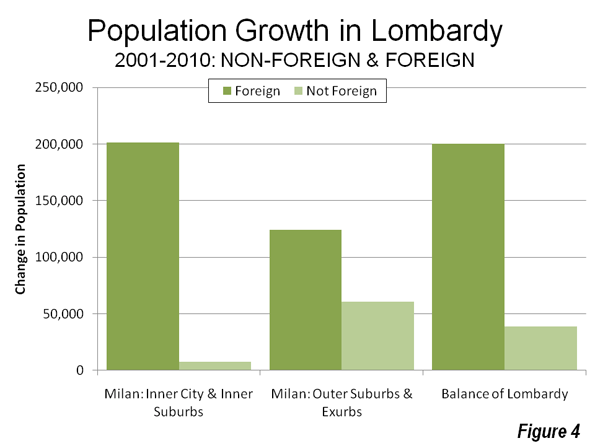
Decentralizing, Diversifying Milan: Like the other international urban areas (Note 3), Milan continues to suburbanize, though growth has also resumed in the historic core municipality. At the same time, international migration is changing Milan and Italy. United Nations (UN) data indicates that the number of international migrants to Italy was 10 times higher in the 2000s than in the 1990s. The UN projects that the inflow will drop by 50 percent between 2010 and 2015 and then to approximately one-third the 2000s influx to beyond 2050. Whatever the result, because of its strong economy, the Milan area will doubtless continue to attract a disproportionate share of the new arrivals.
Wendell Cox is a Visiting Professor, Conservatoire National des Arts et Metiers, Paris and the author of “War on the Dream: How Anti-Sprawl Policy Threatens the Quality of Life”
-----
Note 1: Milan is one of a small number of large urban areas that is often dismissed as being much smaller than it really is. This is because data for metropolitan regions is not routinely produced in Italy and Milan. As a result, analysts often referred to the population of the historical core municipality which has only 20 percent of the metropolitan population. Similar problems of national reporting occur in Germany's Rhine – Ruhr (Essen-Dusseldorf) metropolitan region and Jakarta, Manila and Kuala Lumpur. The Rhine-Ruhr does not appear on the United Nations urban agglomeration list of all over 750,000, despite the fact that it has 7 million people in close proximity, at near average Western European large urban area densities (7,100 per square mile or 2,800 per square kilometer, compared to the Western European average of 8,000 per square mile or 3,100 per square kilometer)
Note 2: More detailed data is not available on the internet from the Istituto Nazionale di Statistica Italia, Italy's statistical bureau.
Note 3: See additional reviews in the "Evolving Urban Form" series, at : Beijing, Chicago, Dallas-Fort Worth, Jakarta, Los Angeles, Manila, Mexico City, Mumbai, New York, Seattle, Seoul and Shanghai .
Photo: Duomo (Cathedral), Milan. Photographs by author.













Some of the suppliers -
Some of the suppliers - Martinrea, máy ảnh chuyên nghiệp chân máy ảnh máy nghe nhạc ipod máy ghi âm phụ kiện laptop điện thoại bàn tổng đài điện thoại tổng đài panasonic máy fax panasonicGetrag and Rassini - are themselves major international players in the auto industry. It no longer makes sense to speak of the North American auto industry in terms of the Detroit Big Three or even the Big Three plus foreign makers
Finally, how will the financial crisis of 2008 affect the North American auto industry? It might be interesting to examine the impact of the financial crisis on the Big Three, on foreign producers and on key automotive suppliers. With North America's population pushing toward 550 million, one could assume, because of the impact of delayed purchasing over the past years. van phong pham The interesting questions are how much - and what - will be produced domestically and, perhaps most interesting of all, who will be the most important players in the industry.
We know that getting a
We know that getting a Vietnam visa is just a small task in preparing for your trip to Vietnam, but often consumes a lot of time and money. Because some people think that getting a Vietnam visa is very complicated, they decide to cancel their trip to Vietnam Vietnam visas We think that in these cases, people have not ben updated on Vietnam visa renewal achievements.
In Vietnam, visa-on-arrival started in 2003 and as of 2011 it is the predominant way tourists from Australia, North America and Europe come into Vietnam Visa to vietnam As Vietnam opens its economic and travelling door, the number of arrivals is on a sharp increase, every time it is counted. Following the rise in the number of international visitors, visa-on-arrival service has grown accordingly to meet the demand. Pioneering this trend vietnam visa online is the international renowned service. Please find below information to see if getting visa upon arrival at the airport good for you or not.
Vietnam visa on arrival is the cheapest way for you. With us, you only pay 20 USD or less, depending on the number of people in your group. And visa for vietnam you will receive authorization to receive visas at the airport. after getting the paper work, Vietnam visa application you will pay an additional fixed charge for each person is: 25 USD/person for single entry, 50 USD/person for multiple entries, and 100 USD/ person for 6 months multiple entries. And no more hidden charged.
For more information please email to vietnam visa on arrival Or hotline: +84.90.824.6047 Kevin Nguyen (Mr)
máy quay sony máy nghe
máy quay sony máy nghe nhạc sony tủ lạnh toshiba tủ lạnh panasonic máy giặt electrolux máy tính tiền Another key issue is how all of these components arrive at their destinations on time loading dock in London on time. lò vi sóng nồi cơm điện máy xay sinh tố máy đánh trứng máy xay thịt máy làm sữa chua máy làm sữa đậu nành máy pha cà phê thiết bị lọc nước quạt không cánh bàn ủi bàn là máy hút bụi This can lead into discussions about factors that impede the system including congestion, the lack of maintenance, the failure of the NAFTA
Some of the suppliers -
Some of the suppliers - Martinrea, máy ảnh chuyên nghiệp chân máy ảnh máy nghe nhạc ipod máy ghi âm phụ kiện laptop điện thoại bàn tổng đài điện thoại tổng đài panasonic máy fax panasonicGetrag and Rassini - are themselves major international players in the auto industry. It no longer makes sense to speak of the North American auto industry in terms of the Detroit Big Three or even the Big Three plus foreign makers
Finally, how will the financial crisis of 2008 affect the North American auto industry? It might be interesting to examine the impact of the financial crisis on the Big Three, on foreign producers and on key automotive suppliers. With North America's population pushing toward 550 million, one could assume, because of the impact of delayed purchasing over the past years. van phong pham The interesting questions are how much - and what - will be produced domestically and, perhaps most interesting of all, who will be the most important players in the industry.
I’m impressed, I must say.
I’m impressed, I must say. Really rarely do I encounter a blog that’s both educative madeira plastica and entertaining, and let me tell you, you have hit the nail on the head. Your idea is hyundai hb20Soutstanding; the issue is sometallpexhing that not enough people are speaking intelligently about. I am very happy that I stumbled across this in my search for something relating to this.